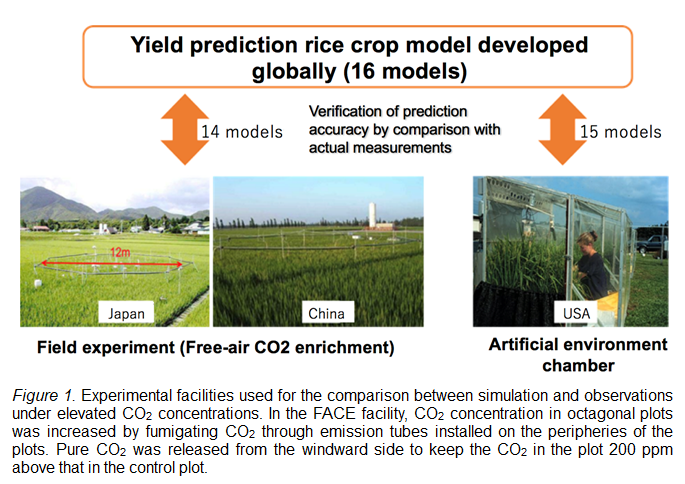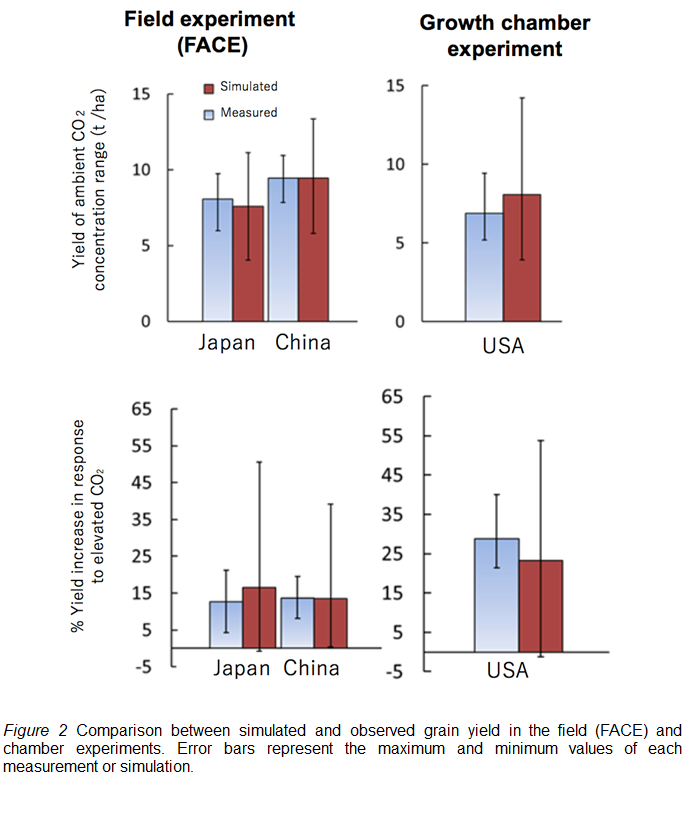A study by researchers at NARO with 18 organizations in nine countries found that multiple crop simulatiom models provide reliable estimates of rice yield in higher CO2 levels in the atmosphere. The study tested 16 rice simulation models against the observed yield under elevated CO2 concentration. The yield prediction response varied significantly among the different models, but the averaged predictions agreed well with the observations suggesting that the effect on rice yield can be accurately predicted using multiple prediction models. The improvement of yield prediction will be an important basis for developing countermeasures against climate change.
Overview
- Accurate prediction of crop yield is increasingly important to develop adaptation measures to climate change. Increasing CO2 concentrations are the major driver of global climate change and have a direct impact on crop yield via increased photosynthetic rates of rice.
- Crop simulation models play a pivotal role in projecting yield in response to a rise in CO2 concentration and are used in various places around the world. However, coordinated evaluation of different models in comparison to observations under elevated CO2 has never been performed.
- NARO collaborated with 18 organizations from nine countries through the Agricultural Model Intercomparison and Improvement Project (AgMIP) to evaluate and compare the accuracy of 16 rice yield prediction models developed around the world. Yield was predicted under an elevated CO2 concentration condition about 1.5 times the current level, which is projected to reach in 50 years from now.
- The simulated results were compared with the observations obtained in two types of experimental facilities (Figure 1); open-field experiments using FACE (Free-Air CO2 Enrichment) facility in Japan and China, and enclosure experiments using environmental-controlled growth chambers in the USA. Under high CO2 concentration, there was about 13% increase in the FACE experiment and about 29% increase in the growth chamber experiment as compared with the control condition.
- The predicted values varied considerably among models, but the simulation averaged over all models agreed well with the measured values of both the FACE and the chamber experiment (Figure 2), suggesting that the multi-model ensemble can be a reliable estimate of the grain yield in elevated CO2.
- The study also identified the major cause of variation among the models, which will help to improve reliability of yield prediction of each model.
- The results were published in the British journal Scientific Reports on November 1, 2017.
Publication
Hasegawa T. et al. (2017) Causes of variation among rice models in yield response to CO2 examined with Free-Air CO2 Enrichment and growth chamber experiments. Scientific Reports 7:14858 (doi:10.1038/s41598-017-13582-y)
For Inquiry
http://www.naro.affrc.go.jp/english/inquiry/index.html
Reference Information






